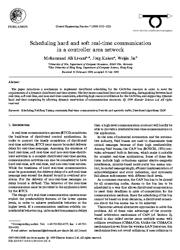A copy of this work was available on the public web and has been preserved in the Wayback Machine. The capture dates from 2004; you can also visit the original URL.
The file type is application/pdf.
Scheduling hard and soft real-time communication in a controller area network
1999
Control Engineering Practice
The paper introduces a mechanism to implement distributed scheduling for the CAN-bus resource in order to meet the requirements of a dynamic distributed real-time system. The key issues considered here are multicasting, distinguishing between hard real-time, soft real-time, and non-real-time constraints, achieving high resource utilization for the CAN-bus, and supporting dynamic hard real-time computing by allowing dynamic reservation of communication resources. A real-time communication system
doi:10.1016/s0967-0661(99)00128-8
fatcat:vtgwvtdk7jhpfhhjns24wu37na

